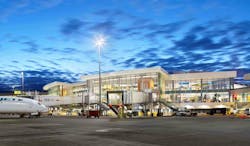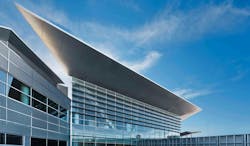Airports around the globe contribute to the local economy, tourism, and trade. They are vital in connecting communities separated by vast rugged terrains and large bodies of water. Airports also produce greenhouse gas (GHG) emissions, which contribute to the rising challenge of climate change. The aviation industry accounts for about 2% of the emissions worldwide; it is estimated that it will reach 3% by 2050.
The planes themselves are getting better when it comes to GHG. Today’s aircraft are 70% more fuel efficient than they were in the 1980s thanks to improvements in fuel, aircraft efficiency, airport operations, and infrastructure. Even more efficient planes—or planes that run on alternative fuels—are on the horizon. It’s a push that is being endorsed by the members of the International Air and Transport Association (IATA) in its road map to Fly Net Zero by 2050. This commitment includes efforts from the airlines, manufacturers, air navigation service providers, and the airports.
Today, most airport operators prioritize and implement ambitious solutions to combat GHGs. One way is to decarbonize the buildings and structures that keep the airport running—while meeting the increasing growth.
On the path to passive
The airport itself is becoming more sustainable. Many new airport construction projects recycle and reuse materials from the outdated terminals. One example is Phoenix Sky Harbor International Airport in Arizona, where our team led the Terminal 2 demolition project. New airports often mandate the use of local materials to reduce their carbon footprint. They also encourage the use of clean alternative power sources. Airports are installing more energy efficient systems for heating, ventilation, cooling, and electrical power and lighting. A prime example is the Vancouver International Airport, which has committed to reach net zero by 2030—20 years ahead of IATA’s goal.
Using local or recycled materials, connecting to a cleaner power grid, and installing high performing efficient systems are steps in the right direction. But to get the airports of the future, we should look at making them as efficient as possible. While many airports are pledging net zero goals, most need further strategies to get there. Today, we can design airports that are climate resilient, durable, long-lasting, and healthy for occupants—we can design airports using Passive House standards.
So, what is a passive house?
Passive house is a building design approach that prioritizes thermal comfort while limiting the energy used to heat and cool the building. It started in the mid-1980s in Central Europe for the design of residential buildings. Now, we can apply it to a wide variety of building types all over the world. Climate-responsive design with an efficient building envelope is key to heating and cooling. These principles are already quite well understood within the building science community.
Today, most airport operators prioritize and implement ambitious solutions to combat GHGs. One way is to decarbonize the buildings and structures that keep the airport running.
We’re seeing them applied in airports around the globe, like the new terminal at the Oslo Airport in Norway. While it is not a certified passive house building, it is considered one of world’s greenest air terminals. The airport expansion cut more than 50% in energy consumption versus the original terminal. How? By using passive design strategies to heat and cool the building. The overall building energy use is comparable to a certified Passive House project. Vigilant environmental assessments and careful sun studies to reduce solar heat gain and loss informed the design. The design even looked at using snow collected during the winter to cool the building in the summer.
How can we incorporate passive strategies in airports?
To look to the future, I drew inspiration from the Oslo airport and Stantec’s passive house projects, such as the Wood Innovation Research Lab. It helps to visualize how we can implement passive design in a terminal.
Super-insulated envelopes
High quality, efficient, and continuous insulation all around the building—from the roofs, walls, and foundations—is critical to minimize heat loss. Just like a warm coat it limits thermal conduction. In the summer, a good insulating layer can also prevent extreme heating events. There are many products available now that blend more efficient and greener insulating materials. We see these in bio-based products like mycelium insulation, a fungi root that has impressive insulating properties. It is also biodegradable, nontoxic, and is sequestering carbon while it’s grown on waste from the agriculture industry.
Airtight construction
Air and moisture can seep through holes and gaps within the building envelope and carry warm air along with it. In a cold climate, warm and moist air from interior spaces seeps through the gaps within the exterior walls. It creates a risk of condensation once it reaches to the colder surfaces of the wall—potentially causing severe damage to wall assemblies. For this reason, it is essential for the building envelope to have a continuous and uninterrupted air barrier.
High-performance glazing and windows
Many terminals have large areas of glass to enhance the passenger experience. While that may seem a conflict with energy efficiency, a Passive House certified building does not have to mean a solid opaque box. Views into the apron are integral part to the passenger experience in airports. Travelers like to watch aircraft take off and land while waiting for their own flight.
In cold climates, triple glazed windows with low-e coating and argon gas will not only help keep the heat inside the building but will also reduce the need to use active heating. It’s important to purposely design and locate these high-performance buildings. Using solar path studies will also take advantage of passively gaining free heat from the sun without sacrificing views.
Thermal-bridge free detailing
Canopies and concrete slabs that extend from interior to exterior spaces are thermal bridges. Even small nails, clips, and bolts penetrating the thermal insulation act as thermal bridges. Any penetration through the thermal insulation can lead to heat transfer from the warm side to the cold side. This can cause two problems in cold climates: a decrease in temperature in the inner surfaces and condensation.
It’s not always possible to eliminate these items. But careful detailing and design can lessen their impact. For example, the design can include thermal breaks like fiberglass clips that play a crucial role in avoiding heat transfer between the interconnecting spaces. Others opt to use less-conductive materials like vinyl windows or doors in lieu of metal.
Now what about a carbon negative airport?
All these strategies should work together as a system. One cannot design a building with the greatest insulation in the world without carefully thinking about airtightness and window thermal bridging. Similarly, we can’t design for the best mechanical system without considering the penetration of the supply and intake duct through the exterior walls.
But where does the heat come from? Once we apply these strategies as a whole, the airport operator can get savings on heating costs by harvesting heat from the occupants, the baggage equipment, and even the computers at the check-in counter. Therefore, we can reduce the size of the ventilation system for this building and free up space to improve the passenger experience and increase revenue and services.
The beauty of a properly designed passive airport is that the building is net zero ready. It consumes so little energy and produces so little carbon that it will likely meet its goal with renewable energy.
Many of the tools we need to achieve carbon negative airports are already available. While we have yet to see a carbon negative and Passive House certified airport, I am confident this is our next destination.
About the Author
Stantec
Published by global design firm Stantec, this eclectic blog features viewpoints, insights, and explanations from Stantec architects, engineers, and designers, on a range of issues impacting the fabric of our communities. Our contributors share their thoughts about design trends, emerging technologies, vexing challenges, and inspired solutions. For more blog posts, visit our Ideas page. Follow us on Facebook, Instagram, LinkedIn, and Twitter, and YouTube.



